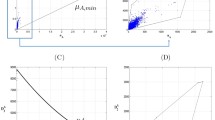Abstract.
Current methods for automatically classifying protein sequences into structure/function groups, based on their hydrophobicity profiles, have typically required large training sets. The most successful of these methods are based on hidden Markov models, but may require hundreds of exemplars for training in order to obtain consistent results. In this paper, we describe a new approach, based on nonlinear system identification, which appears to require little training data to achieve highly promising results.
Similar content being viewed by others
Author information
Authors and Affiliations
Additional information
Received: 16 March 1998 / Accepted in revised form: 2 June 1999
Rights and permissions
About this article
Cite this article
Korenberg, M., Solomon, J. & Regelson, M. Parallel cascade identification as a means for automatically classifying protein sequences into structure/function groups. Biol Cybern 82, 15–21 (2000). https://doi.org/10.1007/PL00007958
Issue Date:
DOI: https://doi.org/10.1007/PL00007958




